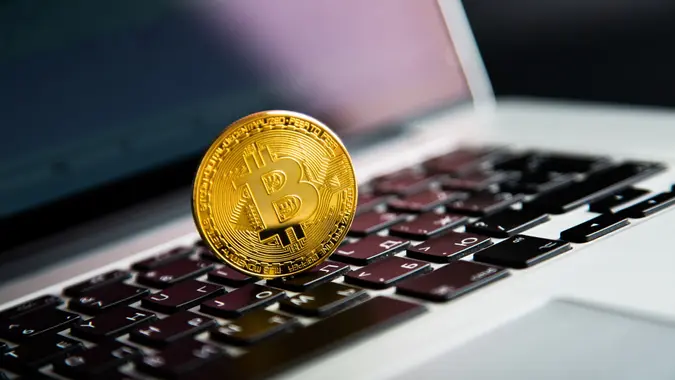Is Bitcoin a Bubble at $100K, or Should I Get in Now?

Commitment to Our Readers
GOBankingRates' editorial team is committed to bringing you unbiased reviews and information. We use data-driven methodologies to evaluate financial products and services - our reviews and ratings are not influenced by advertisers. You can read more about our editorial guidelines and our products and services review methodology.

20 Years
Helping You Live Richer

Reviewed
by Experts

Trusted by
Millions of Readers
It might be hard to believe, but bitcoin is already approaching its 16th birthday, having begun trading in 2009. But unless you’ve been living under a rock, you’ve certainly heard about its amazing returns, as the cryptocurrency rose above $100,000 for the first time in December 2024.
Along with strong performance, however, often comes high volatility, and that’s certainly the case with bitcoin. The crypto skyrocketed over 40% in just the first month after the 2023 presidential election, adding to its long history of erratic price movements.
So, with its price around the $100,000 level, is bitcoin officially a bubble, or is there still time to get in? Here’s a look at both schools of thought.
Bitcoin Price History and Volatility
Even the most ardent bitcoin bulls acknowledge that the cryptocurrency is an extremely volatile asset. In fact, according to an analysis by Fidelity Digital Assets, over the last four years, from 2020 to 2024, “bitcoin has been three to nearly four times as volatile as various equity indexes.” Considering equity markets are generally considered to be among the most volatile of the popular investment classes, this means that bitcoin can be far too volatile for many investors.
Of course, investments should be evaluated on their balance of risk and reward, not simply their absolute risk level. And many would argue that the outsized gains bitcoin has provided to investors over the years compensates them for the risk. While the crypto has had some huge losses in a few calendar years, it’s provided even greater upside. Beginning with the 2009 bitcoin price set by New Liberty Standard, here’s a look at bitcoin’s return by calendar year since it began trading, based on data from Investing.com:
- 2010: 30,203%
- 2011: 1,467%
- 2012: 187%
- 2013: 5,870%
- 2014: -61%
- 2015: 35%
- 2016: 124%
- 2017: 1,338%
- 2018: -73%
- 2019: 94%
- 2020: 302%
- 2021: 60%
- 2022: -64%
- 2023: 156%
- 2024: 121%
Factors Favoring a Higher Bitcoin Price
Those believing that bitcoin will continue to soar higher generally cite one or more of these reasons.
Easing Regulation
Part of the reason bitcoin jumped in price after the November election was that President-elect Donald Trump is seen as being much more crypto-friendly than his predecessor — he has already announced a “crypto czar.”
Restricted Supply
The supply of bitcoin will be permanently capped at 21 million. As there are already nearly 20 million bitcoin in circulation, the cryptocurrency has already nearly reached its maximum lifetime supply.
Positive Cyclical History
According to crypto brokerage Caleb & Brown, bitcoin has run through a fairly consistent cycle consisting of four phases: accumulation, growth, bubble and crash. By their charts, bitcoin is still in the growth phase, which should presumably be followed by a rapid upward expansion in price in the bubble phase.
The Bear Case
Even in the face of bitcoin’s atmospheric rise, there have been plenty of bears imploring investors to avoid the asset class, primarily due to the following reasons.
No Intrinsic Value
Whereas stocks represent actual ownership in various companies and the U.S. dollar is backed by the federal government, bitcoin has no such intrinsic value. The only thing pushing the price higher is the hopeful belief among investors that the price will go higher.
High Energy Usage
According to Global Research and Consulting (GRC) at UC Berkeley, bitcoin uses an unsustainably high amount of energy to produce and transact, and its continued growth will have detrimental effects on the environment and contribute to global warming. This could lead to governmental regulations or restrictions in the future.
Impractical for Daily Use
While bitcoin supporters suggest that the cryptocurrency will eventually become a mainstream transactional currency — perhaps even supplanting the U.S. dollar — as of now, it remains impractical for daily use.
Its sluggish transaction speed, limited acceptance, volatility and creation of capital gains transactions with every use could cause it to remain underutilized. This, in turn, could limit any future price appreciation.
The Bottom Line
The explosive price action of bitcoin has been labeled a bubble by many, but it’s only a bubble if it eventually pops. While the historical price action of bitcoin suggests that the crypto can continue to surge, it’s also likely that, at some point, it will face a massive correction.
The bottom line is that while bitcoin’s future price is unknowable at this point, the fight between bulls and bears will continue to keep the crypto’s volatility high.
 Written by
Written by  Edited by
Edited by 

























